This evening’s concert featured folk music from around the world! Our concert was introduced by long time At-Large Member of Fairfax County School Board, Ilryong Moon. Moon was honored by the Fairfax County School Board in October 2021, for his long service on the school board by naming the main gymnasium at Thomas Jefferson High School for Science and Technology as “Ilryong Moon Gymnasium.”

Aaron Copland’s 1942, “Fanfare for the Common Man.” launched our musical evening. Our music director Christopher Johnston, explains, “The work was inspired in part by a speech made earlier that year by then American Vice President Henry Wallace in which Wallace proclaimed the dawning of the “Century of the Common Man.””
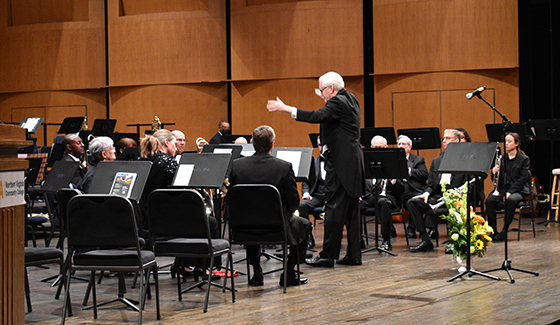
He added Copland’s words, “…It was the common man, after all, who was doing all the dirty work in the war and the army. He deserved a fanfare.”
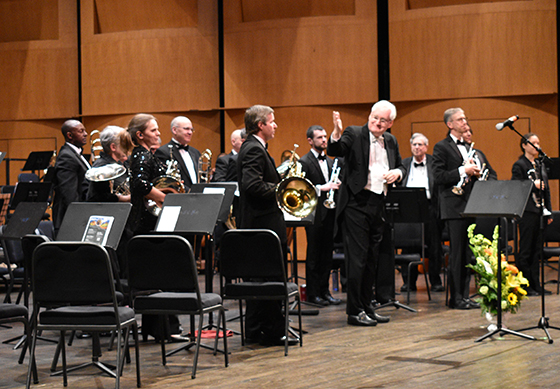
It is interesting to note that Copland considered several other titles for the piece, among them Fanfare for the Spirit of Democracy, Fanfare for the Rebirth of Lidice—a town in Czechoslovakia that had been destroyed by the Nazis—and Fanfare for Four Freedoms. The last title refers to a 1941 speech by President Roosevelt in which he listed the four freedoms people everywhere should enjoy: freedom of speech, freedom of religion, freedom from want, and freedom from fear.
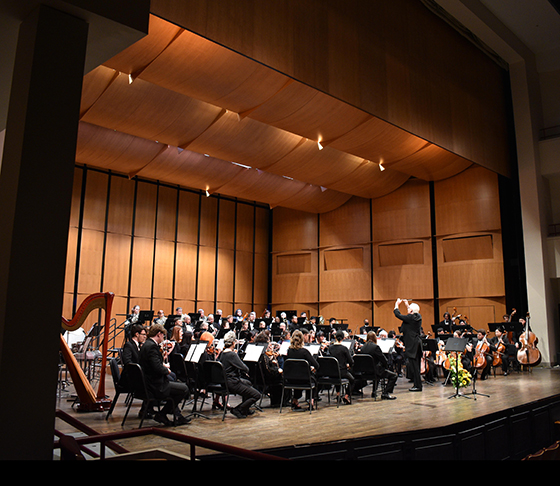
Next we were riveted again by Tchaikovsky’s Symphony No. 2 in C minor, Op. 17″. Chris explains, “Tchaikovsky (1840–1893) composed his Symphony No. 2 in C Minor in 1872 and revised it seven years later. It is Tchaikovsky’s shortest symphony, but what makes this music distinctive is his use of folk tunes for some of its themes….
This technique was favored by “The Five” (Mussorgsky, Borodin, Cui Balakirev, and Rimsky Korsakov), and Rimsky-Korsakov in particular was impressed when Tchaikovsky played this music for him on the piano shortly before the premiere. (Rimsky-Korsakov’s wife liked the last movement so much that she wanted to make a two-piano arrangement of it.)”
Next we enjoyed, Ralph Vaughan Williams’ English Folk Song Suite. Johnston explains, the, “English Folk Song Suite is one of the most popular works of English composer Ralph Vaughan Williams (1872–1958). “It was first published for military band as Folk Song Suite and its premiere took place at Kneller Hall on July 4, 1923, under the baton of Lt. Hector Adkins.”
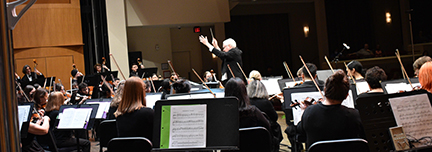
“The piece,” He adds, “was later arranged for full orchestra in 1924 by Vaughan Williams’s student, Gordon Jacob, and published as English Folk Song Suite.”
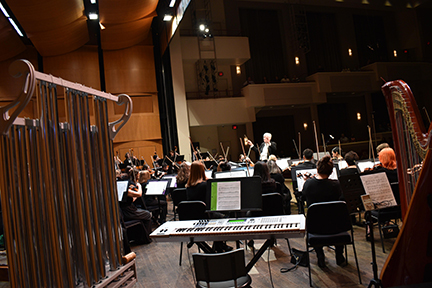
Furthermore, “The suite consists of three movements; March, Intermezzo, and a final March. The first march is entitled “Seventeen Come Sunday,” the Intermezzo is subtitled “My Bonny Boy,” and the final movement if based on four “Folk Songs from Somerset.”
The suite originally had a fourth movement, “Sea Songs,” which was played second, but the composer removed it after the first performance and published it separately with his own orchestration.”
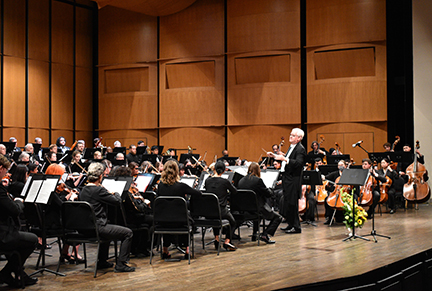


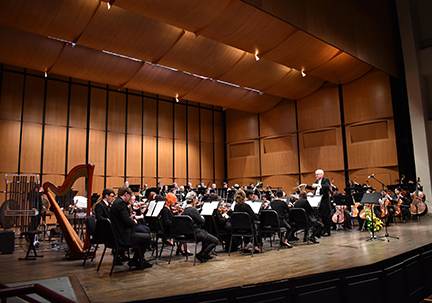
Our evening’s guest conductor is not less than a up and coming composer Charles Stolpe! Tonight he conducted his work,“Voided Dimensions.”
Charles describes his piece as, “Imagine walking in the woods, late at night, with snow falling around you. You are in your thoughts, contemplating life itself and your purpose in it. That is how this piece came to be. The point of “Voided Dimensions” is a melody that played in my head when deep in contemplation. It would start with the main theme playing, moving from soft to loud and feeling chaotic. The theme would return quieting down before ramping back up. There would be a bit of a triumph and victory of reflection before going back to the primary theme once more and fading away but not a complete finish as the void continued.”
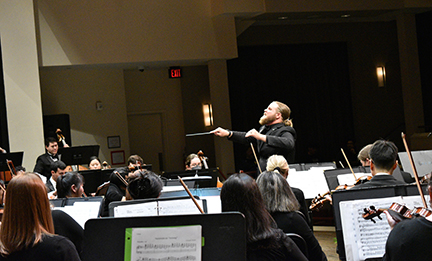
He expands, “The piece begins with an introduction played by the low brass in a soft choral fashion. The main theme begins fully in the strings in a humming-like tune using a minor key representing the void of contemplation in my mind. The melody then gets passed to the woodwinds before the full orchestra comes into play with choral horns in the background. The first chaotic moment occurs as the orchestra builds into a new minor key. The new theme—which is a variation of the main theme— soars through the brass and winds, while the strings and brass play rhythmic and chordal textures in the background with loud percussion adding to the complexity. The orchestra ends that section in full before quieting down as the main theme returns in the strings, winds, and horns along with an added counter melody and chordal background. The second chaotic section begins with the return of the introduction in a march-like style in the woodwinds, while other rhythms and motifs are being played by the other members of the orchestra with the percussion maintaining a chaotic march.
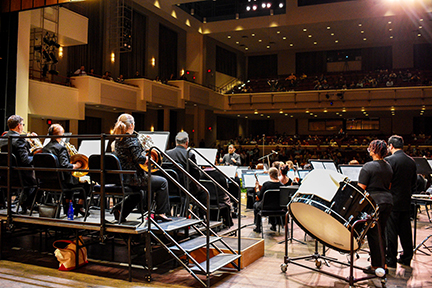
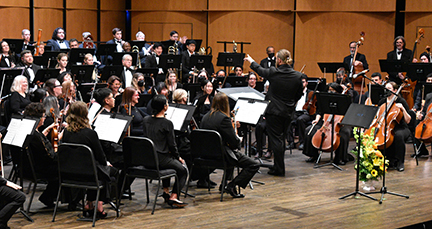
The piece suddenly turns bright and cheerful as the orchestra comes in full, using a major key, inspired by an often-sung church hymn. This part of the piece symbolizes the remembrance of joy and victories of my trials experienced in life. The joy is short lived as suddenly the main theme returns one final time in the strings and added trumpets as the orchestra begins to quiet down and fade away. The piece ends with part of the major theme but played in our home C minor key in the flute with three hits from the timpani to close the piece out.”The piece received a massive and heartfelt ovation! It is such an honor to not only hear a composer’s work but to see them conduct their own score is priceless!
Our next symphonic work was our own Christopher Johnston’s, “Variations on “Arirang” ” featuring Eunju Kwak on violin. Our composing Maestro, Christopher Johnston elucidates, the work was, “composed in 1999, and dedicated to the composer’s niece, Miss Jin Young Koh, the work was first performed at the Eastman Conservatory in Rochester, New York, with Miss Koh performing the violin solo. The Variations were originally composed for violin and piano, but after the initial Eastman premiere, Christopher Johnston (1960– ) scored the piece for full orchestra and solo violin.
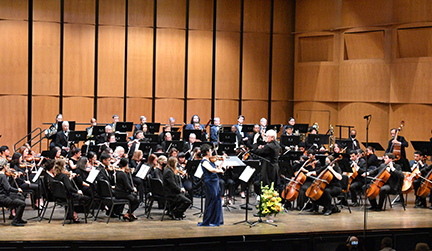
“Arirang” (아리랑) is perhaps the best-known folk song in the Korean language. There are approximately sixty different versions of the song, all of which include a refrain similar to “Arirang, arirang, arariyo.” It is estimated the song is more than 600 years old. In 2012, South Korea successfully submitted the song for inclusion on the UNESCO Intangible Cultural Heritage list. The song is sung today in both North and South Korea and has come to represent a symbol of unity in the region that has been divided since the Korean War.
Lyrics: Arirang, arirang, arariyo…
You are going over Arirang Mountain.
My love, if you abandon me
your feet will be sore before you go ten “li” (miles).
This evening’s performance includes a new, recently composed variation. The NOVA Symphony Orchestra is honored to have Mrs. Eunju Kwak, who performed the Variations with the orchestra in 2015, returning this evening to perform this new version.”
The eveing ended with some Gershwin greats : Selections from Porgy and Bess
Chris explains, “Gershwin (1898–1937) referred to Porgy and Bess as his “labor of love.” Since the opera’s premiere on September 30, 1935, at Boston’s Colonial Theater, it has come to be regarded as one of the greatest works of the American theater. The libretto was written by author DuBose Heyward and lyricist Ira Gershwin. It was adapted from Dorothy Heyward and DuBose Heyward’s play Porgy, itself an adaptation of DuBose Heyward’s 1925 novel of the same name. The premier featured a cast of classically trained African-American singers—a daring artistic choice at the time. After an initially unpopular public reception, a 1976 Houston Grand Opera production gained it new popularity, and it is now one of the best known and most frequently performed American operas.
The libretto of Porgy and Bess tells the story of Porgy, a disabled Black street beggar living in the slums of Charleston. It deals with his attempts to rescue Bess from the clutches of Crown, her violent and possessive lover, and Sportin’ Life, her drug dealer. The opera plot generally follows the stage play.
Some of the songs in the opera, such as “Summertime” and “It Ain’t Necessarily So” became popular and frequently recorded. In the late 20th and early 21st centuries, the trend has been toward productions with greater fidelity to Gershwin’s original intentions. Smaller-scale productions also continue to be mounted.”
Another phenomenal evening of extraordinary music!
Upcoming Orchestra Performances in 2023 include: Summer 2023 Pops Concerts:
Wednesday, July 12, 2023, 8:00 p.m., in Room 118 of the Fine Arts Building on the Alexandria campus of the Northern Virginia Community College and Friday, July 14, 2023, 8:00 p.m., at Mason District Park in Annandale.
The NOVA Symphony Orchestra’s Fall 2023 Classical Concert:
Saturday, November 11, 2023, 8:00 p.m., at the Schlesinger Concert Hall in Alexandria.
The NOVA Symphony Orchestra
A collaborative arrangement between the Northern Virginia Community College’s Annandale Campus music program and the Reunion Music Society, Inc., produced what was then called the NVCC-Annandale Symphony Orchestra in 1994 as a college-community ensemble of musicians. The first rehearsal was held on January 18, 1994, at the Richard J. Ernst Community Cultural Center Theater. Significant contributions to the organization and implementation of the orchestra’s management were made by NVCC faculty member Dr. Gladys Watkins and by Dr. Ann B. Reynolds and Dr. Claiborne Richardson of the Reunion Music Society, Inc. The orchestra’s first concert was performed on April 15, 1994.
The orchestra was officially named “orchestra-in-residence” for the Richard J. Ernst Community Cultural Center in the fall of 1994 under the late Dr. Kay Haverkamp who was the director of the center at the time. Dr. Claiborne T. Richardson and Dr. James Faye served as the first co-conductors. Since that time, the orchestra has provided an excellent opportunity for members of the community to continue or to resume playing a musical instrument. It has also served as a laboratory for NOVA students to learn the orchestral music repertoire.
In 2021, the orchestra was recognized as representing all five campuses of NOVA, and our rehearsal and performance home was moved to the Alexandria campus. Maestro Christopher Johnston has been our Music Director since 1996. This community orchestra comprises both NOVA students earning college credit and community volunteers. For this concert, approximately eighty-five musicians, both professional and advanced amateurs joining with the NOVA students, are taking advantage of this musical expression, embracing the music of different cultures, and performing both standard and new or underperformed orchestral works.
Inquiries from interested musicians and support staff are welcome. Please see our website www.NOVASymphony.org to view our schedule and learn about opportunities to participate as a musician and as a supporter of the arts in our community.
In addition to the Music Director and Conductor, the orchestra’s operations are managed and carried out by an advisory board.






